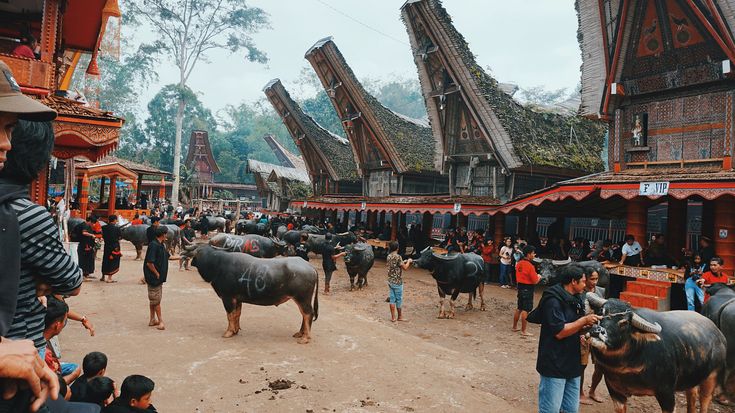
Introduction: Where Death is a Celebration
In the verdant highlands of South Sulawesi, where mist dances between terraced rice fields and jagged cliffs, the people of Toraja turn mourning into magnificence. Rambu Solo’ isn’t just a funeral—it’s a deeply symbolic festival that honors the deceased with a mix of reverence, grandeur, and centuries-old tradition. Amid solemnity, you’ll find laughter, music, feasting, and fierce buffalo battles. It’s this compelling fusion that draws thousands of intrigued travelers each year to witness one of the world’s most elaborate death rituals.
Understanding the Torajan Belief System
The Role of Aluk To Dolo
At the heart of Torajan life is Aluk To Dolo, the “Way of the Ancestors.” This indigenous belief system governs rituals from birth to death and beyond. It defines social conduct, architecture, even farming cycles. In death, it mandates a proper passage to Puya—the afterlife.
Life After Death in Torajan Cosmology
Death in Toraja is not an end, but a transformative journey. Until a proper Rambu Solo’ is held, the deceased is considered only “sick,” still part of the household. Offerings and conversations continue as though the soul lingers. Only through elaborate rites can one’s spirit reach Puya, where ancestors dwell and watch over the living.
What is Rambu Solo’?
Rambu Solo is not merely a funeral. It is a profound rite of passage that elevates the dead to the afterlife with dignity, ceremony, and a cascade of customs rooted in ancestral belief. This ceremony reflects the Torajan philosophy of life and death, where one’s final journey is a communal celebration, often taking place months or even years after a person has died, depending on the family’s financial ability to prepare.
You can explore more about the cultural background of Rambu Solo on the official Indonesian Cultural Heritage website.
Timing and Duration of the Ceremony
These ceremonies are usually held weeks, months, or even years after death, once the family has gathered enough resources. Spanning three to ten days, or more, Rambu Solo’ is a monumental undertaking. It’s not unusual for dozens of pigs and tens of buffaloes to be sacrificed in a single ceremony, underscoring both love and social standing.
A Multi-Day Spectacle: Key Rituals of Rambu Solo’
Sacrificial Rites and Buffalo Fights
Buffaloes are more than livestock—they are spiritual vehicles. The more that are sacrificed, the swifter the journey to Puya. Onlookers gather in packed arenas to witness tedong silaga, buffalo fights that are both sport and sacred spectacle. The event pulses with drumming, shouting, and the crack of clashing horns.
The Ma’badong Dance and Chanting Circles
Evenings echo with the somber, hypnotic rhythms of Ma’badong, a circular chant-dance performed by male elders. Dressed in ceremonial garb, they sway in synchronized reverence, singing elegies that recount the deeds of the deceased. It is communal grieving turned performance art.
Final Procession to the Cliff Tombs
The culmination is a grand procession where the coffin is carried—often with boisterous effort and ceremony—toward family burial sites carved into rock cliffs. Some are suspended in caves or placed within elaborately decorated wooden crypts. Here, the soul is believed to finally rest, guarded by Tau-Tau effigies that stand watch like silent sentinels.
Symbolism and Sacred Traditions
Why Buffaloes Are Central to the Ritual
The buffalo, or tedong, is a spiritual compass. Its strength is thought to aid the soul’s journey through cosmic terrain. Rare breeds, especially albino tedong bonga, are prized and can fetch astronomical prices—sometimes equaling the cost of a small house.
The Tau-Tau Effigies and Ancestral Guardianship
Hand-carved Tau-Tau statues resemble the deceased, dressed in ceremonial finery, and placed near their tombs. These effigies don’t merely memorialize—they’re believed to embody ancestral presence. They gaze out across the valleys as if ensuring the family’s prosperity from the spirit realm.
The Community and Cultural Tourism
Roles of the Extended Family and Village
A Rambu Solo’ is never a solo endeavor. It mobilizes entire clans and communities. Neighbors contribute labor, livestock, or logistical support. These shared responsibilities are acts of collective devotion and social solidarity. Status is displayed not through words, but through participation and contribution.
The Ceremony’s Allure for Global Travelers
For visitors, Rambu Solo’ is a rare window into a worldview where death is not feared but embraced with pageantry. Tourists come with curiosity and often leave with a deeper sense of life’s transience—and the creative ways humans make sense of it. Still, respectful observation is essential; one steps not into a show, but into sacred memory.
To make your journey into the heart of Toraja seamless and enriching, Toraja Journey offers curated experiences led by local guides who understand the region’s rich spiritual heritage. Whether you’re interested in witnessing a Rambu Solo’ firsthand, exploring hidden burial caves, or staying in traditional Tongkonan houses, Toraja Journey helps you connect deeply with both the land and its people.
Preservation Amid Modernity
Challenges of Balancing Tourism and Sacredness
Modern cameras now click beside ancient chants. As Toraja opens to the world, concerns rise about commodification. Some ceremonies are now timed for tourist seasons, leading to debates within communities about authenticity versus opportunity.
Local Efforts to Safeguard Rambu Solo’s Integrity
Torajan elders, cultural custodians, and younger generations are working to strike balance. Workshops, oral history projects, and even digital archiving seek to preserve the essence of Rambu Solo’ without diluting its spirit. Respectful tourism guidelines and community-driven scheduling are emerging as part of the solution.
Conclusion: Death, Devotion, and the Living Legacy of Toraja
Rambu Solo’ is more than a funeral—it is a symphony of faith, family, and farewell. It entwines the sacred with the social, the mournful with the majestic. In celebrating the dead, the Torajans reaffirm life itself. And for those who witness it, there lies an unforgettable reminder: death is not always an end, but a doorway carved in stone, watched over by those who came before.
